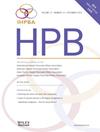Revisiting the place of surgical portal decompression for adults with noncirrhotic portal hypertension due to chronic extrahepatic portal vein obstruction: a scoping review
IF 2.7
3区 医学
Q2 GASTROENTEROLOGY & HEPATOLOGY
引用次数: 0
Abstract
Background
Liver cirrhosis accounts for more than 90 % of portal hypertension cases, and the other cases are due to noncirrhotic portal hypertension (NCPH). Variceal bleeding is the most life-threatening complication of portal hypertension and its primary treatment is medical according to the Baveno VII guidelines. This review discusses the evidence on surgical portal decompression for adult patients with NCPH secondary to chronic extrahepatic portal vein obstruction (EHPVO).
Methods
This is a scoping review of the evidence for the feasibility and effectiveness of surgical portal decompression in adults with NCPH secondary to EHPVO.
Results
This scoping review yielded 17 studies, including a total of 110 patients. Patient age(s) ranged from 19 to 68 years, with the majority undergoing nonphysiological (i.e., portosystemic shunts) shunts (N = 84, 76.4 %), mostly for variceal bleeding refractory to medical and endoscopic treatments. Physiological shunts (i.e., Rex shunts) had a potential advantage over nonphysiological shunts in postoperative rebleeding (5 % vs. 10 %) and hepatic encephalopathy rates (0 % vs. 13 %). Conversely, nonphysiological shunts had a potential advantage over physiological shunts in postoperative shunt thrombosis (8 % vs. 22 %).
Discussion
This scoping review reported that surgical portal decompression is feasible in adults with NCPH due to EHPVO with favorable outcomes and long-term patency.
慢性肝外门静脉梗阻所致成人非肝硬化门静脉高压症行门静脉减压手术的回顾性研究。
背景:肝硬化占门静脉高压症的90%以上,其余为非肝硬化门静脉高压症(NCPH)。静脉曲张出血是门静脉高压最危及生命的并发症,根据Baveno VII指南,其主要治疗是医学治疗。本文综述了成人NCPH继发于慢性肝外门静脉阻塞(EHPVO)的手术门静脉减压的证据。方法:这是对成人继发于EHPVO的NCPH手术门静脉减压的可行性和有效性的证据进行综述。结果:本综述纳入17项研究,共纳入110例患者。患者年龄从19岁到68岁不等,大多数患者接受了非生理性(即门静脉分流)分流术(N = 84, 76.4%),主要是因为静脉曲张出血对药物和内窥镜治疗难治性。在术后再出血(5% vs. 10%)和肝性脑病发生率(0% vs. 13%)方面,生理性分流术(即Rex分流术)比非生理性分流术具有潜在优势。相反,在术后分流血栓形成方面,非生理性分流术比生理性分流术有潜在优势(8%对22%)。讨论:这篇综述报道了手术门静脉减压对于EHPVO导致的成人NCPH是可行的,具有良好的结果和长期通畅。
本文章由计算机程序翻译,如有差异,请以英文原文为准。
求助全文
约1分钟内获得全文
求助全文
来源期刊

Hpb
GASTROENTEROLOGY & HEPATOLOGY-SURGERY
CiteScore
5.60
自引率
3.40%
发文量
244
审稿时长
57 days
期刊介绍:
HPB is an international forum for clinical, scientific and educational communication.
Twelve issues a year bring the reader leading articles, expert reviews, original articles, images, editorials, and reader correspondence encompassing all aspects of benign and malignant hepatobiliary disease and its management. HPB features relevant aspects of clinical and translational research and practice.
Specific areas of interest include HPB diseases encountered globally by clinical practitioners in this specialist field of gastrointestinal surgery. The journal addresses the challenges faced in the management of cancer involving the liver, biliary system and pancreas. While surgical oncology represents a large part of HPB practice, submission of manuscripts relating to liver and pancreas transplantation, the treatment of benign conditions such as acute and chronic pancreatitis, and those relating to hepatobiliary infection and inflammation are also welcomed. There will be a focus on developing a multidisciplinary approach to diagnosis and treatment with endoscopic and laparoscopic approaches, radiological interventions and surgical techniques being strongly represented. HPB welcomes submission of manuscripts in all these areas and in scientific focused research that has clear clinical relevance to HPB surgical practice.
HPB aims to help its readers - surgeons, physicians, radiologists and basic scientists - to develop their knowledge and practice. HPB will be of interest to specialists involved in the management of hepatobiliary and pancreatic disease however will also inform those working in related fields.
Abstracted and Indexed in:
MEDLINE®
EMBASE
PubMed
Science Citation Index Expanded
Academic Search (EBSCO)
HPB is owned by the International Hepato-Pancreato-Biliary Association (IHPBA) and is also the official Journal of the American Hepato-Pancreato-Biliary Association (AHPBA), the Asian-Pacific Hepato Pancreatic Biliary Association (A-PHPBA) and the European-African Hepato-Pancreatic Biliary Association (E-AHPBA).
 求助内容:
求助内容: 应助结果提醒方式:
应助结果提醒方式:


